Date Built: 1935-1936
Original Owner: Government
Original Use: Post Office
Subsequent Uses: Federal building housing various government departments
Previous Building on Site: Old Post Office
THE
HEART OF THE CITY
POST OFFICE
80 King Street East
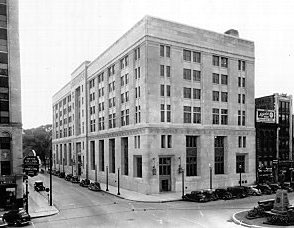
![]() BUILDING INFORMATION
BUILDING INFORMATION
Date Built: 1935-1936
Original Owner: Government
Original Use: Post Office
Subsequent Uses: Federal building housing
various government departments
Previous Building on Site: Old Post Office
![]() ARCHITECTURE
ARCHITECTURE
Size: Six-storeys
Design and Style: Modern Classical
Architect, Builder: Eli Van Allen (builder);
Houton & Souter (architects)
Construction Materials: Canadian Limestone
Architectural Integrity: N/A
Architectural Features: Rich architectural detailing, exterior stone ornamentation at the cornice
and belt-course the crowing narrative relief of the frontispiece, the coat of arms over
the front door, the bronzework of the window and door panels, the use of marble
wainscotting on the interior, as well as bronze grillwork, mosaics and quality
craftsmanship.
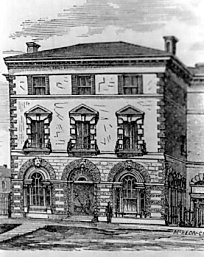 The first Post Office,
which opened in 1825, was located on Main Street near James Street. The first postmaster
was W.B. Sheldon and it was said that he kept a cow, carried on a barber business, and
dyed clothing, all while expected to deliver the mail. If parcels and letters were not
picked up at the Post Office, they were only delivered when enough had accumulated to
warrant delivery. From its first location, the office moved to the first government owned
Post Office, located on James Street North in 1831. It then moved to a three-storey
building located at King and John Streets, in 1856. The ground floor of this location
served as a Post Office, while the upper floors housed the postmaster.
The first Post Office,
which opened in 1825, was located on Main Street near James Street. The first postmaster
was W.B. Sheldon and it was said that he kept a cow, carried on a barber business, and
dyed clothing, all while expected to deliver the mail. If parcels and letters were not
picked up at the Post Office, they were only delivered when enough had accumulated to
warrant delivery. From its first location, the office moved to the first government owned
Post Office, located on James Street North in 1831. It then moved to a three-storey
building located at King and John Streets, in 1856. The ground floor of this location
served as a Post Office, while the upper floors housed the postmaster.
The year 1856 went down in Hamilton as the year of unknown and unexplained fires. Attempts were made to burn down the City Hall, the Post Office, Central Public School and other important public buildings. In November of that year, it was discovered that an unoccupied home near the Post Office had been entered, the plaster of a partition had been removed, and the hole filled with shavings saturated with oil. The same material had been placed on the floor of the rooms leading to the Post Office. The scheme was caught in time and the building did not burn.
In 1879, a disastrous fire demolished the McInnes Block,
which was also associated with the Bank of Hamilton, and the
southwest corner of King and John Streets, leaving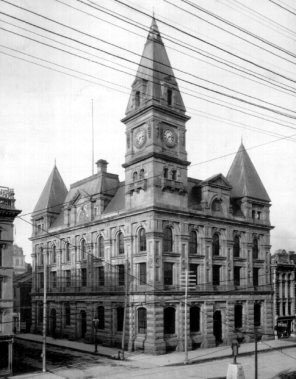 the site empty. In 1882, the Dominion government,
purchasing the land for $45,000, started work on a new central Post Office. The building,
taking four long years to erect, officially opened on October 23, 1886. The architecture
was a mixture of Elizabethan and Corinthian. The main contract for the project was given
to Van Allen & Love, while smaller jobs were given to various smaller local companies:
MacKay & Boyde, plastering; Adam Clark, plumbing; Duthie & Son, slating; Irving
& Son, galvanized iron work and roofing; J. Garland, painting and oil finishing; J.J.
Blackmore, heating; and Brown & Love, masonry.
the site empty. In 1882, the Dominion government,
purchasing the land for $45,000, started work on a new central Post Office. The building,
taking four long years to erect, officially opened on October 23, 1886. The architecture
was a mixture of Elizabethan and Corinthian. The main contract for the project was given
to Van Allen & Love, while smaller jobs were given to various smaller local companies:
MacKay & Boyde, plastering; Adam Clark, plumbing; Duthie & Son, slating; Irving
& Son, galvanized iron work and roofing; J. Garland, painting and oil finishing; J.J.
Blackmore, heating; and Brown & Love, masonry.
The building, from the ground floor to the top of the tower, measured 140 feet. The slated spire stood 35 feet tall, and the lead pinnacle stood 19 feet high. The walls were made from reddish-brown sandstone and the roof was fabricated from Nova Scotian quarried slate. The interior was decorated with highly ornamental hand-carved pieces, of which no two were identical. The public area of the Post Office and the Customs Office were decorated with fine carvings. The interior ceilings were seventeen feet high, and the building was equipped with fifteen fireproof vaults. All private offices were provided with marble topped wash stands, complete with silver-plated taps. Hoodless and Sons were given the contract for supplying the carpeting and furnishings.
In the 1920s and the 1930s, the need for a centralized Federal building arose because government offices were scattered across the city. The old Post Office closed in November of 1934, and was slated for demolition later that year. An article in the Spectator dated April 17, 1935, described the demolition. "Construction men wrecking the old federal building declare themselves amazed at the strength of the Post Office tower. It has taken longer proportionately to demolish than any other part of the building. The late Eli Van Allen, who built the edifice, must have intended his work to last several hundred years, they say. After the stone facing was removed, the brick wall itself was found to be three feet , and in some places even five feet thick. The stone overhead was found to be embedded in the tower, and the whole structure is one of extreme solidity." (Spectator, April 17, 1935).
During the demolition, the cornerstone of the building was opened and inside, a jar was
found. The jar contained " an unbelievable quantity of tightly rolled newspapers
including the Canadian Almanac of 1883, the Canada Gazette, the Ontario Gazette, the
Evening Tribune, the Labour Union, the Globe Daily Mail, Hamilton Times, and the Hamilton
Spectator." Also included were several coins. "The coins included five coppers,
four five-cent pieces, two dimes, one 25-cent piece and one 50-cent piece, all of the 1882
mint." (Spectator, May 4, 1935).
The Dominion Public Building was built in 1935 as part of a federal public works program, which intended to employ construction workers that were badly affected by the Great Depression. The new building was designed by the local architectural firm of Hutton & Souter, rather than by the Public Works Architect. The building, made from Canadian limestone, stood six-storeys high, and extended from King to Main Streets along John Street. The building was designed in a Modern Classical fashion and the entrances faced John and Main Streets. The main entrance faced John Street.
The cost of the 1936 federal building, which housed the Post Office, was $1,600,000. The three facades were treated with classic simplicity, while the sculptured frieze on John Street South, and the coat of arms graven in the stone over the main entrance, added to the ornamentation. William H. Yates, contractor for the new Post Office, stated that there would be no cornerstone for the new building since it was a Federal building.
The John Street Post Office housed many government offices, including the Customs Department, Labour Departments, Pension Department, and the National Health Department. The ground floor was occupied by the Postal and Customs departments. The second and third floors were used for the Post Office working space and Customs examining workhouse, while the fourth floor contained offices, the customs’ storage area, and the Postal Parcel and Express departments. The fifth floor housed the offices of the Assessor, the Cashier and Accounting departments and the Tax and Inspector departments. Located on the sixth floor were the departments of Marine, Agriculture, Immigration, Gas and Electrical Inspectors, Relief Pensions and the Royal Canadian Mounted Police. The space in the basement was given to loading docks, parcel post, mail chutes, weights and measures and vehicle access.
The Hamilton Building was said to have one of the finest interiors of any federal Post
Office building. The postal lobby, otherwise known as the Public Square, had walls
constructed from red and brown marble, with a contrast of colour added in the glass mosaic
maps. The floor was made from brown and grey marble, and the ceiling was painted in
colours, which highlighted the warm light atmosphere created by the marble floors. The
doors, customer desks, and wickets were bronze. Red mastic tile was used in the working
spaces throughout the building and the floors of these areas were covered in red linoleum.
All the corridors and floors above the main floor were coloured terrazzo with heavy brass
dividing strips. There were four Otis elevators inside the building, the doors of which
were hollow bronze cast with bronze ornamentation. All materials used in the building were
Canadian.
Today, the building is recognized as an important landmark for the City of Hamilton belonging to the group of large office blocks built by the Federal Government across the country during the 1920 and 1930s. Hamilton’s Dominion Public Building has been ranked as one of the three best examples of large federal public buildings erected in the country. The classical inspiration found in the design of the building is illustrated in the pilasters, columns, symmetry, the rectangular block form, and the general horizontal divisions of the base, shaft and cornice. The John Street Post Office was and is the largest building on the block.
In July of 1951, an East End sub-Post Office located at Main and Tuxedo Streets was opened. The building was designed by D.J. Kyes and built by Cooper Construction. In September of that same year, another postal station opened on the mountain at 583 Concession Street. This station provided full postal service. Two years later, in June of 1953, the Sun Life Assurance Company of Canada erected a building on the site of the old Post Office on James Street. The front of the new building was made of Ohio stone and the main entrance had massive granite pillars on each side and overhead ornamentation to complete the design.
The Post Office, having to serve the rapidly growing population of the city, found the need for expansion. The building next to the Post Office proved to be an ideal location for the expansion. In 1960, the government purchased the Lees Building and premises for approximately $150,000. The land had been in the Lees family, one of the oldest established firms in Hamilton, for over a century. The building, which housed George H. Lees & Co. was slated for demolition.
An article in the Spectator, dated June 2, 1961, reported that an L-shaped, one storey building facing Main Street was to be added to Hamilton’s central Post Office. The building was to be used as a lobby for the handling of incoming and outgoing post. The cost of the addition was estimated at around $152,500, and was built by Wilchar Construction Company of Dundas. The company was also commissioned to install new mail chutes in the main building.
In September of 1967, a new Post Office, "Postal Station F" was built on
Upper James south of Mohawk Road. By the mid 1970s, mail sorting was done automatically by
computer-run letter sorter machines which were capable of processing mail at a rate of
20,000 pieces per hour.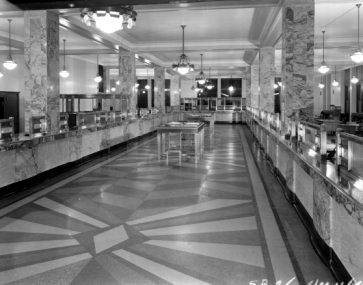
Throughout the twentieth century, the Post Office adopted many new services. In 1910, Hamilton was selected as the first rural mail route serving the area between the city and Ancaster. In 1914, parcel post service was established, while in 1921 and 1922 insurance of parcels, and cash on delivery services, were introduced. Airmail was introduced in 1927. In 1929 Hamilton had its first direct service when airmail service, extending between Montreal and Windsor, stopped in Hamilton. 1941 and 1942 saw the introduction of air graph letters and air letters. The Post Office extended its door-to-door postal delivery service in a number of areas in Hamilton West in November of 1960. In the early 1970s, the Post Office offered coin-operated photocopy services, priced at ten cents a page. In 1974, the Post Office introduced a new postal coding system, the postal code.
The uniforms worn by mail carriers had drastically changed from the early days of postal service to present day. In the late 1970, postal carriers wore Bermuda shorts made of tropical weight cloth, falling to three inches above the knee, with black socks, black shoes, and short-sleeved shirts. The uniforms of the early postal workers were the same for winter and summer. They wore long tunics, trousers, shoes (much like army shoes which had to be polished daily), leather belt, helmet, and a mailbag. They also wore a white collar and tie, and the tunic was tied just under the chin. In the cold winter months, an overcoat was added. The uniform was quite military in nature.
The Post Office was hit by waves of crime, including arson and robbery. In April of 1967, it was reported that a number of mailboxes had been broken into. It was believed that 30 Hamilton and 14 Grimsby mailboxes had been opened with screwdrivers or crowbars. Cash and cheques in the boxes were the believed reason for the break-ins. Valueless mail was tossed onto the roadways after being ripped and damaged. In the following month it was reported that the total number of mailbox robberies in Hamilton, Grimsby and Dundas stood at 50.
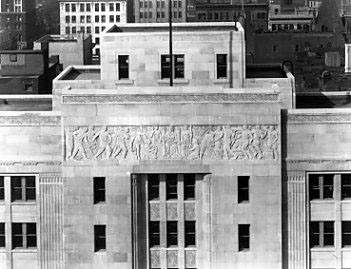 On November 20, 1971, Post Office
officials discovered a package containing six sticks of dynamite leaking nitroglycerin. No
fuses or detonators were found with the package. The motive, according to one of the
police officers investigating the crime was simple, "It’s likely some nut just
wanted to see his name in the paper." (Spec November 20, 1971).
On November 20, 1971, Post Office
officials discovered a package containing six sticks of dynamite leaking nitroglycerin. No
fuses or detonators were found with the package. The motive, according to one of the
police officers investigating the crime was simple, "It’s likely some nut just
wanted to see his name in the paper." (Spec November 20, 1971).
In June of 1989, Hamilton Regional Police created a team of detectives to investigate a rash of related break-ins to Post Offices and postal substations. Thieves had stolen somewhere between $120,00 to $150,000 in stamps and cash. The largest theft in the region occurred in March that same year when thieves broke into the Post Office in Waterdown and made off with $40,000 to $50,000 in stamps and cash.
The three mechanized mail-processing plants in Hamilton, Burlington, and St. Catharines closed, and the employees were transferred to the Stoney Creek plant in May of 1990. In the early part of the following year, Hamilton’s historic downtown Post Office closed. The federal government purchased the building for $6,700,000. The Post Office opened another sub-station on Cannon Street at Wellington. The Cannon facility was to serve large business customers requiring bag mail and postage-meter setting.
The government eventually purchased and renovated the Dominion Public Building for an estimated $64,000,000 and turned it into a Court House, which housed eighteen courtrooms, uniting under one roof, all courts except the United Family Court. The move into one centralized building saved the government from paying over $2,000,000 in rent annually. The renovation project included the addition of a seventh floor and the construction of a tower on the West Side. The main entrance was located on Main Street. The courthouse was designed without a full-service cafeteria, which was intended to force people outside for lunches and dinners to benefit local businesses and establishments. The new Court House was named after Hamiltonian John Sopinka, Supreme Court Justice who died in 1997.
See also: www.canadapost.ca
REFERENCES: